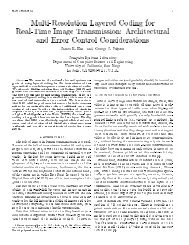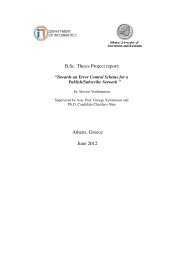In Network Processing and Data Aggregation in
In Network Processing and Data Aggregation in
In Network Processing and Data Aggregation in
You also want an ePaper? Increase the reach of your titles
YUMPU automatically turns print PDFs into web optimized ePapers that Google loves.
Tree. To be more specific, as the query is distributed across the network, a spann<strong>in</strong>g treeif formed from the sensors, <strong>in</strong> order to return data back to the root node. Dur<strong>in</strong>g the datacollection (sens<strong>in</strong>g) phase, each leaf node produces a s<strong>in</strong>gle tuple <strong>and</strong> forwards it to itsparent. The non-leaf nodes receive the tuples of their children <strong>and</strong> comb<strong>in</strong>e these values.Afterwards, they submit the new partial results to their own parents. F<strong>in</strong>ally, the totalresult will arrive at the root after h steps, where h is the height of the aggregation tree. Ifthere are no failures, this technique works extremely well for decomposable aggregates,namely distributive <strong>and</strong> algebraic aggregates such as MIN, MAX, COUNT <strong>and</strong> AVG.When a query <strong>in</strong>volves an epoch, requir<strong>in</strong>g read<strong>in</strong>gs to be collected periodically, TAGuses the periodic per-hop adjusted aggregation approach. It subdivides the epoch <strong>in</strong>toslots. The length of each slot is equal to the epoch length divided by n, where n is themaximum number of hops separat<strong>in</strong>g the nodes that generate data from the s<strong>in</strong>k. By us<strong>in</strong>gthe per-hop adjusted aggregation operation, slots are assigned to nodes <strong>in</strong> decreas<strong>in</strong>gorder (i.e. n, n-1, n-2,…) as the query propagates through the network. Each nodetransmits <strong>in</strong> its slot thus, the nodes that transmit first are the outmost nodes whereas thenodes that transmit last are those that are closest to the s<strong>in</strong>k. As <strong>in</strong> any time-slottedmechanism, clock synchronization among nodes is required so that nodes transmit <strong>in</strong>their designated slots.Nevertheless, the tree-based approach of TAG breaks down when failures are<strong>in</strong>troduced <strong>in</strong>to the system. Especially <strong>in</strong> sensor networks, both node <strong>and</strong> l<strong>in</strong>k failures arevery common phenomena. Node failures are expected to be relatively frequent, s<strong>in</strong>ce thesensors are meant to be small, cheap as well as mass-produced <strong>and</strong> they will be placed <strong>in</strong>a variety of uncontrolled environments. L<strong>in</strong>k failures (<strong>and</strong> packet losses) are alsoexpected to occur very often due to environmental <strong>in</strong>terference, packet collisions, <strong>and</strong>low signal-to-noise ratios. Furthermore, if a node fails or its message does not reach itsparent, the values associated with the entire subtree are lost. . If the failure occurs close tothe root node, then the effect on the result<strong>in</strong>g aggregate can be significant.<strong>In</strong> order to improve the performance of the TAG service, several optimizations havebeen proposed with significant results. Concern<strong>in</strong>g the conservation of energy, sensornodes sleep as much as possible dur<strong>in</strong>g each step where the processor <strong>and</strong> radio are idle.When a timer expires or an external event occurs, the device wakes <strong>and</strong> starts to performthe process<strong>in</strong>g <strong>and</strong> communication phases. At this po<strong>in</strong>t, as mentioned above, it receivesthe messages from its children <strong>and</strong> then submits the new value(s) to its parent. If no more








